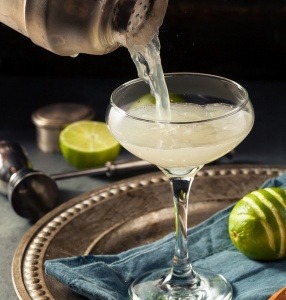
Born in Burma, in the farthest reaches of the British Empire, The Pegu Club is a classic that evokes a touch of the tropics.
It was in Rangoon, Burma—now renamed to Yangon, Myanmar—that The Pegu Club was first brought into the world.
As in the case of several now-classic serves—the Gin & Tonic, the Gimlet—The Pegu Club is a product of Britain’s colonial ambitions. 1852 was the year the Brits took control of Burma; by 1871, The Pegu Club in Rangoon was both an unofficial headquarters for British army officers and something of an oasis amidst the tropical heat. Rudyard Kipling himself once described the club as “full of men on their way up or down.” Hardly a surprise, then, that The Pegu Club’s eponymous house drink was created to be a potent and refreshing serve, with a tart, citric piquancy that made it ideal for sultry-weather sipping.

The Pegu Club—in present-day Yangon, Myanmar—is where this storied cocktail was born.
Though it began life in one of the most distant edges of the British Empire, The Pegu Club quickly grew in popularity, and its reputation soon travelled beyond Southeast Asia. The first written record of the drink dates to Harry MacElhone’s ABC of Mixing Cocktails, published in 1922. The legendary Harry Craddock was next to publish his take on the serve, in the 1930 edition of the Savoy Cocktail Book. By then, the drink was no less than an international sensation. As Craddock wrote in his introduction to the drink, it was “one of the favourite cocktails of The Pegu Club, Burma, and one that has travelled, and is asked for, around the world.”
What made the cocktail so popular and innovative? On paper, its ingredient list—gin, lime juice, orange curacao, Angostura bitters, and orange bitters—reads simply enough. But the way the tartness of the lime tangles with the brightness of the orange curacao, and the depth contributed by the two varieties of bitters, makes for a drink that’s both quenching and complex.
Though the recipe ended up travelling far and wide, the Pegu Club itself wasn’t to last: the club shuttered in the 1940s when the British left Burma. Though the building still stands today, it remains in a state of decay, fenced off and barely hinting at its former prestige.

Thanks to its mingled flavours of lime and orange, plus two different varieties of bitters, the Pegu Club is a surprisingly complex drink.
Helping to carry on the name these days is legendary bartender Audrey Saunders. When she opened Pegu Club in Manhattan in 2005, it not only found its place in a pantheon of ground-breaking New York drinking dens—it also helped revive the classic cocktail. Though Saunders’s version is a subtle tweak on the original (she increased the ratio of lime juice and decreased the orange curacao, to make for a more refreshing flavour profile), it remains one of the menu’s most popular entries.
Can’t make it to Manhattan to sample her version for yourself? Not to fear—the Pegu Club is a breeze to make at home, and is sure to please whoever you’re hosting.
Recipe: The Pegu Club
Feature images © bhofack2/iStock; Instants/iStock; Wikimedia Commons
